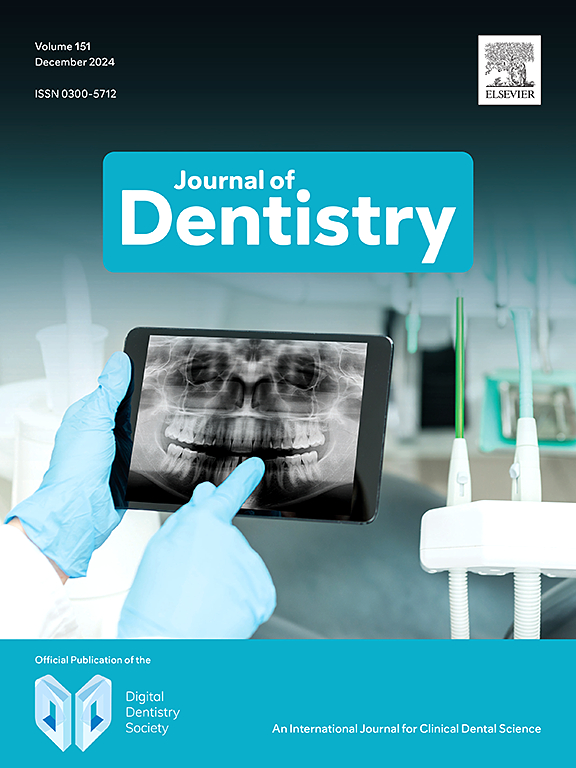Load-bearing capacity of screw-retained fixed dental prostheses made of monolithic zirconia on different abutment designs and abutment-free implant connection
IF 4.8
2区 医学
Q1 DENTISTRY, ORAL SURGERY & MEDICINE
引用次数: 0
Abstract
Objectives
A new abutment-free implant connection allows for direct screwing of FDPs on implants to avoid complications caused by cement rests or screw loosening, which may affect to screw torque and load distribution. The objective of this study was to test the initial (Fi) and final failure (Ff) loads and torque changes of abutment-free monolithic zirconia CAD-CAM fixed dental prostheses (FDPs) compared to titanium FDPs on different abutment designs.
Methods
Three-unit screw-retained FDPs (n = 50) on two implants (n = 100) were divided into groups (n = 10) based on the implant-abutment connection and material of the supra-structure: (1) abutment-free monolithic CAD-CAM zirconia FDP (Abut-free-Zr), (2) abutment-free veneered titanium FDPs (Abut-free-Ti), (3) monolithic zirconia FDPs with titanium base abutments (Zr-Ti-Base), (4) monolithic zirconia FDPs on multi-unit abutments (Zr-MU), (5) veneered titanium FDP on multi-unit abutments (Ti-MU). All specimens were subjected to thermo-mechanical aging (1′200’000 Cycles, 49 N, 1.67 Hz, 5º to 50º C, dwelling time 120 s). Torque of the screws was measured, and static loading was performed. Data were tested using ANOVA and Tukey's tests (p < 0.05).
Results
After thermo-mechanical aging, all screws showed reduced torque, Ti-MU significantly more reduction compared to Abut-Free-Ti (p = 0.0021). Titanium groups showed significantly lower Fi (N) values (171.4–230 vs 1272–1358,) due to veneering porcelain fractures (p = 0.0001) and significantly higher Ff (N) (2922 –3029 N vs. 1272–1358) values than zirconia groups (p < 0.0001).
Conclusions
Three-unit abutment-free monolithic zirconia FPDs showed similar failure loads compared to other zirconia groups, while the titanium groups exhibited superior final failure loads. Different abutment designs did not seem to affect the failure loads.
Clinical Significance
The specific design of the novel implant interface allows for the fabrication of implant supported FDPs with personalized design directly on implant level without abutments. The monolithic zirconia FDPs on abutment-free implant connection can be used with good confidence since they exhibit similar mechanical stability as monolithic zirconia FDPs on titanium-base or multi-unit abutments.
不同基台设计及无基台种植体连接方式下单片氧化锆螺钉保留固定义齿的承载能力。
目的:一种新的无基台种植体连接允许将fdp直接螺钉固定在种植体上,以避免水泥休息或螺钉松动引起的并发症,这些并发症可能影响螺钉扭矩和负载分布。本研究的目的是测试不同基台设计下,无基台的整体氧化锆CAD-CAM固定牙体(FDPs)与钛固定牙体(FDPs)的初始(Fi)和最终失效(Ff)载荷和扭矩变化。方法:将2个种植体(n=100)上的3单元螺钉保留FDP (n=50)根据种植体-基牙连接方式和上部结构材料分为组(n=10):(1)无基牙单片CAD-CAM氧化锆FDP(无基牙zr),(2)无基牙贴面钛FDP(无基牙ti),(3)钛基基单片氧化锆FDP (Zr-Ti-Base),(4)多单元基牙单片氧化锆FDP (Zr-MU),(5)多单元基牙贴面钛FDP (Ti-MU)。所有试件进行热-机械老化(1’20’000 Cycles, 49N, 1.67 Hz, 5º~ 50ºC,停留时间120 s),测量螺钉扭矩,并进行静加载。使用方差分析和Tukey检验对数据进行检验(结果:热机械老化后,所有螺钉均显示扭矩减小,Ti-MU比Abut-Free-Ti明显减小(p=0.0021)。由于贴面瓷断裂,钛组的Fi (N)值显著低于氧化锆组(p=0.0001) (171.4-230 vs 1272-1358), Ff (N)值显著高于氧化锆组(2922 -3029 N vs 1272-1358) (p结论:三单元无基台整体氧化锆FPDs的破坏载荷与其他氧化锆组相似,而钛组表现出更强的最终破坏载荷。不同的桥台设计似乎对破坏荷载没有影响。临床意义:新型种植体界面的特殊设计允许直接在种植体水平上制造具有个性化设计的种植体支持的fdp,而无需基台。单片氧化锆FDPs与单片氧化锆FDPs在钛基基或多单元基台上具有相似的机械稳定性,因此可以放心地使用无基台种植体连接。
本文章由计算机程序翻译,如有差异,请以英文原文为准。
求助全文
约1分钟内获得全文
求助全文
来源期刊

Journal of dentistry
医学-牙科与口腔外科
CiteScore
7.30
自引率
11.40%
发文量
349
审稿时长
35 days
期刊介绍:
The Journal of Dentistry has an open access mirror journal The Journal of Dentistry: X, sharing the same aims and scope, editorial team, submission system and rigorous peer review.
The Journal of Dentistry is the leading international dental journal within the field of Restorative Dentistry. Placing an emphasis on publishing novel and high-quality research papers, the Journal aims to influence the practice of dentistry at clinician, research, industry and policy-maker level on an international basis.
Topics covered include the management of dental disease, periodontology, endodontology, operative dentistry, fixed and removable prosthodontics, dental biomaterials science, long-term clinical trials including epidemiology and oral health, technology transfer of new scientific instrumentation or procedures, as well as clinically relevant oral biology and translational research.
The Journal of Dentistry will publish original scientific research papers including short communications. It is also interested in publishing review articles and leaders in themed areas which will be linked to new scientific research. Conference proceedings are also welcome and expressions of interest should be communicated to the Editor.
 求助内容:
求助内容: 应助结果提醒方式:
应助结果提醒方式:


